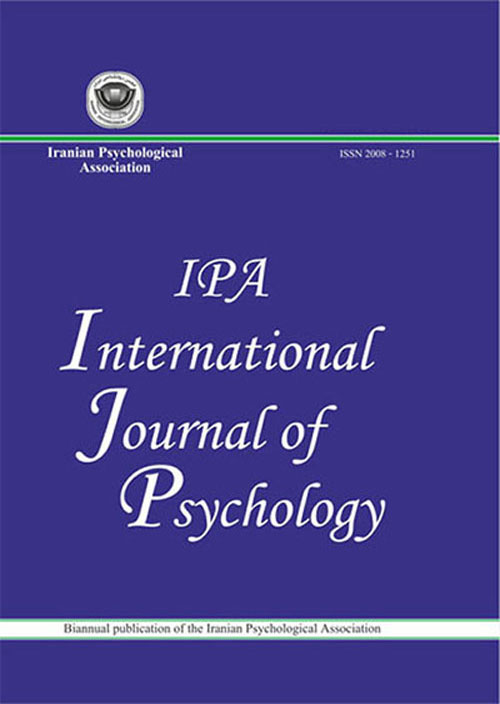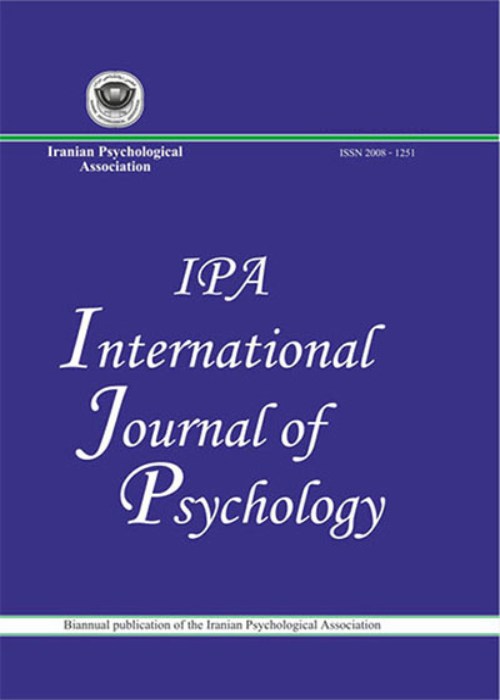فهرست مطالب

International Journal of Psychology
Volume:14 Issue: 2, Summer-Autumn 2020
- تاریخ انتشار: 1400/06/17
- تعداد عناوین: 8
-
-
Pages 10-53The present study aims to show to what extent horizontal and vertical individualism and-collectivism tendencies predict social well-being, with the intermediary role of social problem-solving. For this purpose, 377 students from universities located in the capital cities of the western provinces in Iran were selected through the multistage sampling method. The Horizontal and Vertical Individualism and Collectivism (Triandis, 1998), the Social Well-Being (Keyes, 2004), and the Social Problem-solving Ability (D’Zurilla et al., 2002) questionnaires were applied in this study. The analysis of the data, based on the formation of the causal model in the Smart PLS 3.2.8 software, shows that the general model of the project matches our data. The results of the validity and reliability factors of the external model are optimal. In the internal model, collinearity criteria, the amounts of t, F2, and Q2 are acceptable. Also, the coefficient of determination (R2) of efficient problem-solving (50.3%), inefficient problem-solving (48.3%), and social well-being (68.2%) were obtained at appropriate levels. In addition, the results reveal that horizontal and vertical individualism and collectivism predict social well-being through social problem-solving ability both directly and indirectly. But the horizontal collectivism does not significantly affect social problem-solving ability. Moreover, the direct relationship of efficient and inefficient problem-solving on social well-being is all meaningful (P≤.01). Finally, the analysis of the MIPA indicates that the highest performance and importance are related to the horizontal individualism variable (69.250) and efficient problem-solving (.299), which is indicative of the implicit applicability of these results.Keywords: Social Problem-solving (Efficient & Inefficient), Horizontal, Vertical Individualism-Collectivism, social well-being
-
Pages 54-80Researchers found that one of the factors affecting nurses experiencing occupational stress was the difference in their enneagram personality triads. The aim of the present research was to investigate the psychic profile of nurses' enneagram personality triads based on the psychological components of the SCL-90. The method of this study was descriptive-correlational. The statistical population of this research comprised all of the nurses working in Shiraz public hospitals in 2017. 270 people were selected from this population through multistage random sampling based on Krejcie, & Morgan sample size table. The results showed that there was a significant difference between a nurses' instinct and thinking triads in terms of obsession, aggression and psychosis. There was also a significant difference between the instinct and feeling triads of the nurses in terms of obsession and aggression. Meanwhile, there was no significant difference between personality triads in terms of other psychological components. Some enneagram personality triads in nurses were prone to the occurrence or absence of mental symptoms. Although the findings explain only a 19% variance, hospital managers should consider the nurses’ personality triads in order to improve their performance.Keywords: Enneagram, Nurses, Personality Triads, Psychic Profile, SCL-90
-
Pages 81-107Firefighters are among the first groups who deal with injuries from accidents. They are significantly at risk for disorders such as PTSD. This study aimed to compare the cognitive performance, mood and emotion regulation in firefighters with and without PTSD. This study, from July to October 2016, utilized a descriptive, causal-comparative approach and the statistical population consisted of all firefighters in Isfahan. The selection criterion in this study was work experience for one consecutive year. The sample included 40 firefighters with and without post-traumatic stress disorder (PTSD) selected by a random cluster sampling. In so doing, 11 fire stations in Isfahan were randomly selected from 24 stations. The firefighters at each of these stations were divided into two groups; with PTSD and without PTSD, based on their answers to the Mississippi questionnaire. The measuring instruments were the Color Tracking Test, the London Tower test, subscales of the Wechsler memory test, Beck Depression Inventory, and Garnofsky’s Emotion Regulation questionnaires. The collected data were analyzed by SPSS 22 software by Mean Standard Deviation analysis, Shapiro-Wilk’s normality, and multivariate analysis of variance ANOVA tests. The results showed that there were significant differences between the scores of cognitive performance, mood and emotion regulation in firefighters with and without PTSD (p< .01). In addition, there were significant differences in firefighters, with and without PTSD (p< .01), between the scores of the time and error in first-try of attention, B and C levels of executive functions, digit span total score and forward digit span of working memory, mood and subscales of emotion regulation including positive re-evaluation, reaching a perspective and subjective rumination.Keywords: Firefighter, Posttraumatic Stress Disorder, Cognitive performance, mood, emotion regulation
-
Pages 108-131The purpose of this study was to investigate the fitness of the model of the effect strengths-based psychological climate on job well-being, positive affect, and life satisfaction, with the mediating role of strengths use. The statistical population of the study consists of the employees of one of the Ahvaz Oil Companies, among whom 120 were selected randomly through simple random sampling. Then, the participants were asked to complete the Strengths-based Psychological Climate (Van Woerkom & Meyers, 2015), Strengths Use (Govindji and Linley’s, 2007), Job Well-being (Parker & Hyett, 2011), Positive Affect (PANAS; Watson, Clark, & Tellegen, 1988) and Life Satisfaction Questionnaires (Diener, Emmons, Larson, & Griffin, 1985). Structural Equation Modeling (SEM) was used to test the research model. Also, to investigate the significance of the indirect effects of the research model, the bootstrapping method was used. The direct effects of the model showed the significant effect of strengths-based psychological climate on the strengths use. It was also shown that the effect of strengths use was significant on Job well-being, positive affect, and life satisfaction. Finally, the results showed that all of the indirect effects of the model were significant and the strengths-based psychological climate had a significant effect on the Job well-being, positive affect, and life satisfaction with mediating role of strengths use. Therefore, the proposed model had good fitness. The results of this research suggest that strengths-based psychological climate can have a significant impact on personal and organizational outcomes.Keywords: strengths-based psychological climate, strengths use, job well-being, Positive affect, life satisfaction
-
Pages 132-157The purpose of this study was to design and test a model to investigate the effect of mental strength and mindfulness on marital satisfaction considering the mediating role of parenting stress in mothers of exceptional children. In this descriptive-correlational study, the statistical population consisted of all mothers of exceptional children in Ahvaz. A sample of 264 women was selected through convenient sampling method. The instruments were Clough, Earle & Sewell (2002) Mental Strength Questionnaire (2002), Baer, Smit, Hopkins, Krietemeyer & Toney Mindfulness Questionnaire (2006), Enrich Marital Satisfaction Scale of Olson, Fournier, and Druckman (1985) and Abidin's Parenting Stress Index (1990). The proposed model was evaluated by path analysis method. Bootstrap test was used to test indirect relationships. The results showed significant and direct relationships between mental strength and parenting stress, mindfulness and parenting stress, parenting stress and marital satisfaction and mindfulness and marital satisfaction but there was no significant relationship between mental strength and marital satisfaction. Based on the results, the proposed model is a well-fitting model and is considered as an important step in determining the effective factors in the marital satisfaction of mothers.Keywords: Mental strength, Mindfulness, marital satisfaction, Parenting stress
-
Pages 158-183This research aimed to evaluate and explain the prediction of attitude role towards infidelity due to media consumption mediated by inefficient attitude, marital conflicts, and sexual satisfaction. This study's participants consisted of 300 persons were selected from married students referring to Kermanshah Azad University counseling center in 2017 who were selected by simple random sampling. The research measures consisted of the attitude towards infidelity, inefficient attitudes, media consumption questionnaires, marital conflicts, and sexual satisfaction scales that after ensuring their voluntary attendance, the questionnaires were completed by the participants. Structural equation modeling (SEM) through Lisrel and SPSS 22 was used for data analysis. The results revealed that Media consumption directly as well as indirectly and through inefficient attitudes, marital conflicts, and sexual satisfaction affect attitudes toward infidelity. Moreover, media consumption directly affects inefficient attitudes, marital conflicts, and sexual satisfaction. Inefficient attitudes, marital conflicts, and sexual satisfaction directly affect attitude towards infidelity. Inefficient attitudes directly affect marital conflict, and marital conflict directly affects sexual satisfaction.Keywords: Marital conflicts, sexual satisfaction, attitude towards infidelity, Media consumption, inefficient attitudes
-
Pages 184-216Human resources are one of the most important assets of an organization, and improving the psychological well-being of employees is one of the most important tasks of managers. This study aimed to estimate the role of psychological capital and mindfulness on Structural modeling of psychological well-being. Statistical population consisted of all education employees in Tehran's education staff in 2019. The sample consisted of 610 participants selected randomly from the population. In this research, the following scales were used, including; Psychological Wellbeing Questionnaire of Ryff & Keyes (1995), the Psychological Capital Scale of Luthans & Avolio(2007) and the Mindfulness Questionnaire of Baer (2006). Data analysis was done using SEM and Amos20 Software. The obtained results showed that the research model fit indicators were reliable, and the proposed model had an optimal fit. According to this study's findings, it can be concluded that the psychological capital variable incurs direct and indirect effects (due to mindfulness) which is a positive and significant predictor for the psychological well-being of employees (t-value = 5.091, p<0.05, and 95% CI). The results indicate the importance of the role of psychological capital and mindfulness in predicting psychological well-being. Therefore, the level of psychological well-being of employees can be improved with proper planning to strengthen psychological capital and mindfulness.Keywords: structural equation modeling, Psychological Well-Being, psychological capital, Mindfulness
-
Pages 217-246The purpose of this study was to investigate the construct validity of the Assessment and Development Center of Managers in the National Iranian Oil Company. The research method is based on the applied purpose and in terms of data collection is descriptive-analytical. The statistical sample includes data obtained from the evaluation of 384 managers who were selected from the database of managers by simple random sampling. These data were analyzed based on the multi-trait-multi-method and the confirmatory factor analysis. The overall fit indices showed that the data fit the model very well. The examination of the individual parameter estimates indicates that while both dimension and exercise factors contribute to the ratings, the estimates for exercise parameters are substantially larger in all cases than estimates for dimension factors (mean parameter estimates of .39 and .68 for the dimension and exercise parameters, respectively). In addition, inter-correlations among the latent dimension factors ranged from 0.98 to 1.0, providing evidence of no discriminant validity across dimensions. Thus, these results support and are consistent with those obtained from the correlational analyses. To put it short, the exercise factors are the primary determinants of assessment center ratings.Keywords: assessment centers, Construct validity, discriminant validity, dimension, Exercise


